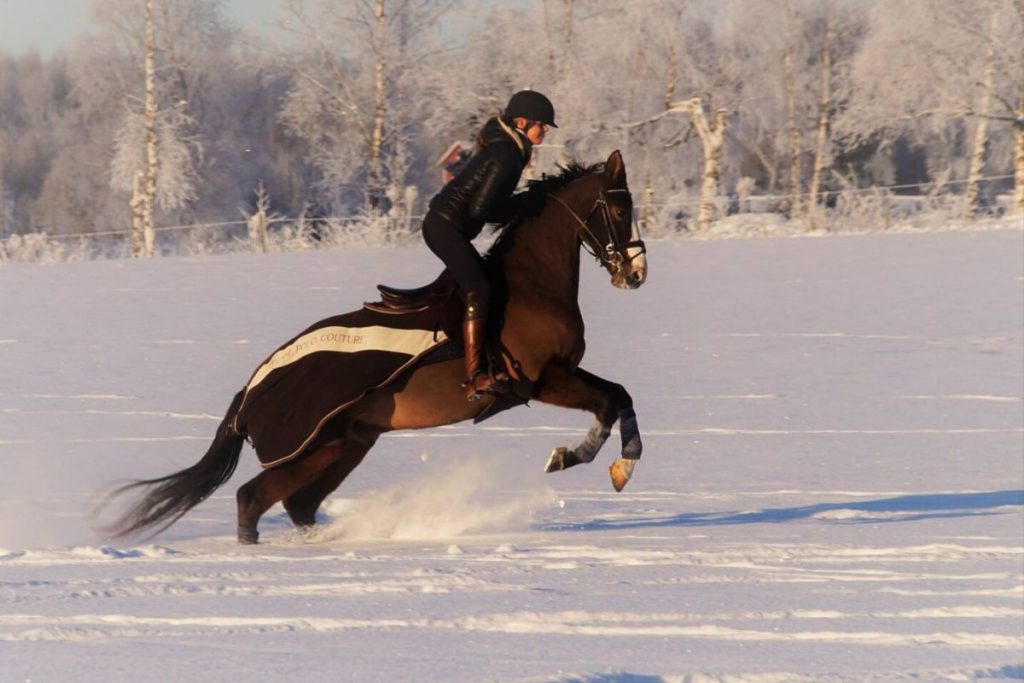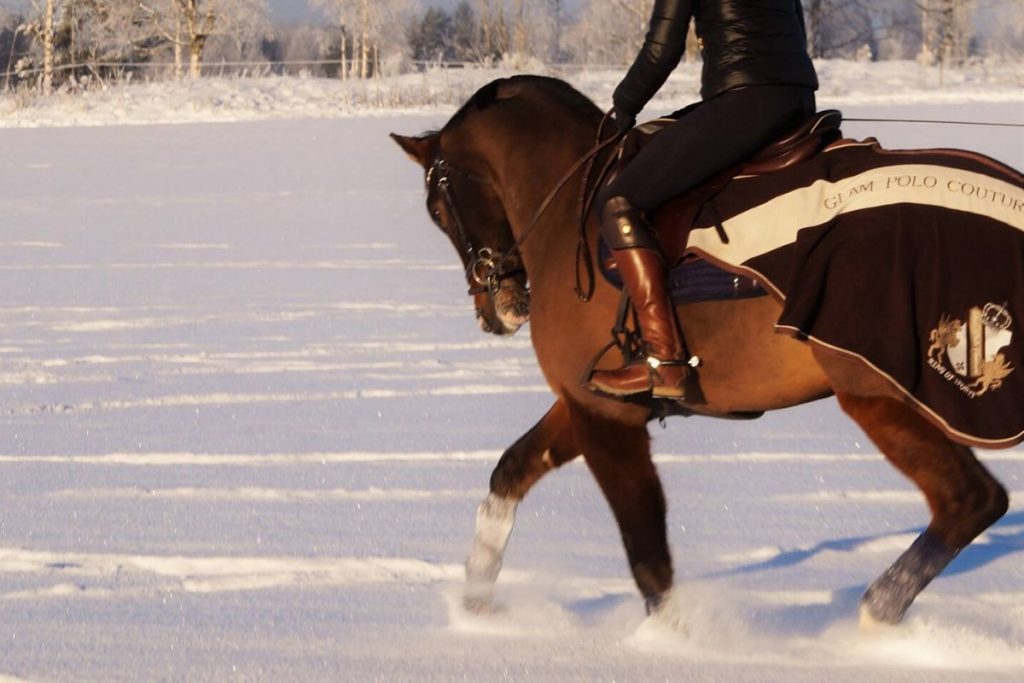When horse-riding, what you wear is very important. It’s not just about fashion. Wearing the right clothes, including long pants, is essential to having a safe and fun ride.
Clothing does not have to be expensive, but it is important to make sure that they are comfortable and will provide proper protection.
Do you have to wear long pants when horse riding? You do not have to wear long pants when horse riding, but you should. It is possible to ride wearing something shorter than long pants. However, this can lead to chafing, pinching, and other discomforts from your bare leg rubbing on the saddle. Therefore, wearing long pants while riding a horse results in a safer and more comfortable ride.
Wearing shorts or shorter pants can easily lead to discomfort and create a safety hazard, especially on trail rides. Long pants not only protect against “saddle burns,” but they also protect the legs against any hazards encountered during the ride that could injure the rider.
This article will explain why long pants are the best choice for horse-riding and give you some ideas of long pants that you can choose from.

Why Should You Wear Long Pants When Horse Riding?
The decision to wear long pants while horse-riding is entirely up to the preference of the person riding the horse; however, it is recommended to wear long pants because they can help prevent saddle sores, trail injuries, and other uncomfortable issues.
Most often, riders choose to wear jeans or riding tights. However, there are some instances that riders prefer shorts, though, such as bareback horse-riding.
What are Saddle Sores?
Saddle sores are caused by three things: pressure, friction, and sweat. Because the human body is designed more for walking than for riding, you place pressure on skin and muscles that normally do not have that type of strain. Rider’s clothing can be either part of the solution or part of the problem, which is one of the main reasons that long pants are considered a must by many people.
Long pants do not mean that it has to be jeans. Jeans are seen as mandatory “cowboy” attire and can be a great barrier against any hazards along the trail. However, they often do not prevent saddle sores.
Jeans can often be very uncomfortable to ride because they can:
- Increase body temperature
- Cause sweating, which can increase chaffing
- Be too tight causing chaffing/sores
- Bunch up and lead to chaffing and saddle
My Horse University’s article, “The Do’s and Don’ts of Equestrian Attire,” by Jennifer Nadeau and Betsy Greene, who are both Equine Extension Specialists at universities, explains that the best long pants to prevent saddle sores tend to have a skin-tight fit but are stretchy to provide comfort and prevent bunching.
This type of fit also allows the rider to move freely while keeping the skin from getting pinched or chaffed by the saddle or the pants, causing extra friction.
Shorts and Saddle Sores
In hot weather, it can be very tempting to wear shorts to stay cool, but shorts often increase your risk of getting sores. They do not protect the legs from friction and the tender skin of the inner thigh and calf rub on the saddle. It also sets you up to have your skin pinched between the saddle flap and stirrup leather.
Riding in shorts can often increase sweating, not decrease it. As bare skin rubs against the leather of the saddle, this can increase sweat and make the skin “stick” to the saddle, interfering with the legs’ free movement. The sweaty skin will result in rough movement over the leather instead of smooth sliding as with pants. This increases the risk of saddle sores.

Consider Trail Hazards
When riding across the open countryside, it is important to wear long pants to protect your legs – not just from saddle sores but from any sharp objects, tree branches, etc. along the side of the trail that could cause an injury to your legs. It is also important that the pants be tight enough that they do not catch on objects, causing an injury.
Jeans are the most popular trail riding pants because the material offers the most durability and protection factors. However, as stated above, jeans can increase your chance of saddle sores. Choosing jeans specifically designed for riding can help decrease potential problems.
Some of the features of riding jeans to look for include:
- Flat inside seam to prevent rubbing.
- Pant legs that are long enough to stay tucked into your boots while sitting in the saddle.
- Jeans that are made of softer material.
- Jeans that have some stretch to them.
- Jeans that have a tighter fit without being overly tight.
All of these features will help make sure the jeans do not cause problems with increased friction or pressure while protecting the legs from hazards.
Riding Bareback
Some people choose to ride horses without a saddle, called riding bareback. This eliminates the problem of saddle sores. However, with no saddle to help “hold” you on the horse, the rider must grip the horse with their legs while riding.
This means that they need to choose to wear something that will help them grip strongly with their legs. Some riders believe they can grip better when their bare legs are in contact with the horse.
However, even without the risk of saddle sores, trail hazards still pose a threat of injury unless you are riding in an exhibition ring. Some riders do not consider this much of a risk and choose to ride in shorter pants or shorts when riding bareback.
Do You Need Riding Tights?
Riding tights have become the yoga pants of the horse-riding world. They are very similar to yoga pants but offer better protection against saddle sores and trail hazards. They are specifically designed for horse riding and offer many benefits that make them the best choice when riding.
Some of the benefits of riding tights include:
- Good Grip: Riding tights are designed with a full seat grip, often made with silicone, that helps you “stick” in the saddle. This improves your seating, which decreases friction and increases safety.
- Wide Waist: A wide waistband can be found on most riding tights. This prevents discomfort caused by riding with more restrictive waistbands.
- Belt Loops: Belt loops are optional, but they are included on some riding pants. This can make it possible to use a belt when riding.
- No Cut-Outs: Many styles of tights, such as yoga pants or running tights, have cut-outs or other accents to increase their fashion value. However, these cut-outs present places where your legs could become raw from rubbing the saddle through the cut-out. Riding tights do not have cut-out accents.
- Pockets: Most other tights and riding attire, other than jeans, do not have pockets. This makes it difficult to hold your cell phone and other items while riding. Most riding tights have a special cell phone pocket. These pockets are placed on the outer leg or top of the thigh to make them more accessible while riding.
- Long-Lasting: Riding tights are made more durable than other tights to stand up to the friction of the saddle.
- Comfortable: Riding tights are made to be worn all day. Their lightweight breathable material allows comfort without bunching.
- Proper Length: Both yoga pants and some other forms of tights are cropped-length. This creates a gap between your boots and pants that can rub on the leather tack or get nicked by tree branches. Riding tights are made full-length to prevent rubbing and injury.
You do not have to ride in riding tights, but they can be a great alternative to wearing jeans. They protect from saddle sores, keep you safe from trail hazards, and are often more comfortable than jeans. Riding tights can be expensive, though. So, make sure you shop around to find some that fit your budget.
Final Thoughts
Horse-riding can be a great experience when wearing proper clothes. Long pants help reduce friction and pressure on sensitive skin, decreasing the chance of saddle sores. They also provide a barrier against sticks, sharp objects, and any other hazard along the trail. You do not have to ride in long pants but doing so provides comfort and protection.
